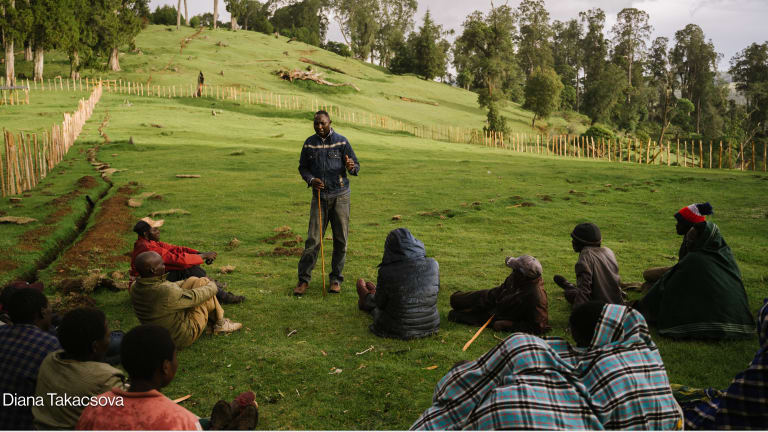Working in conservation: 3 things for development pros to know
Cutting across food security, agriculture, water access, health, and poverty, what do development professionals need to know about conservation? Devex asks the experts.
The official definition of conservation, as per Merriam-Webster, is to preserve and protect. Whilst broad by nature, oftentimes conservation is only thought of in terms of the protection of endangered species. It is so much more than that, say those Devex spoke to on the sidelines of the 8th International Union for Conservation of Nature’s Asia Regional Conservation Forum in Bangkok, Thailand. However, because of this misconception, it is often siloed from the broader development agenda. Yet conservation plays a critical role in the Sustainable Development Goals. SDG 15, life on land, for example, focuses on protecting and restoring land-based ecosystems while SDG 14, life below water, is centered around conserving oceans and marine resources. Amid the triple planetary crisis of climate change, pollution, and biodiversity, conservation work is vital. Its intersection with other SDGs, such as access to water, health, poverty, and hunger, is ever more obvious, said Loris Palentini, country director at the World Wildlife Fund-Laos. “We are not some strange beast living in the forest. We share the same kind of issues and problems [as the rest of the sector],” he explained. The trifactor of threats are killing plants and animals, but their existence also feeds into the fertility of soil, accessibility of water, and food systems, all of which then impact people. “I don’t want people to be confused that this is just about saving plants and animals. We have to understand that this is about saving our own species. This is about having the right ecosystems that give us food and that maintain our life on this planet,” said Grethel Aguilar, director-general of IUCN. “We cannot see the environment in one corner and poverty, health, even education and clean water in another box. Everything links together and we have to have this holistic view of conserving our planet.” With that in mind, various experts shared with Devex what they feel the broader development sector needs to know about conservation. Conservation work isn’t just for conservationists Typically, conservationists are presumed to be zoologists, marine biologists, hydrologists, scientists, and environmental lawyers. While many are, Aguilar believes that a plethora of roles touch, or should touch, conservation in some way. “We are the people who save species and plants, but this is very far away from just being the tree huggers and about the most beautiful animals. This is a fundamental issue of our prosperity and needs to be at the center of everything we do, no matter what your job is,” she said. For example, Palentini shared that WWF, which has been focussed on wilderness preservation and the reduction of human impact on the environment since 1961, has, over the years, begun to work with other NGOs on issues that may not have traditionally been seen as conservation-related. WWF works with Care International on gender-based violence and climate change and with World Vision on research around Indigenous plants and supplementary feeding for school children. “The idea of trying to look more into how we can complement each other, rather than how to compete has been working quite well,” he said, adding that “there is more and more the need to work together.” The staff in those partner organizations could now be considered as contributing to conservation efforts alongside their primary focus. Palentini himself also doesn’t have a traditional conservation background. He began his career as a psychologist before working for a number of NGOs focussed on maternal health, child trafficking, and HIV/AIDs in places such as Zimbabwe, Ethiopia, and Vietnam. He eventually transitioned into conservation, focussing initially on rhino protection, driven purely by passion. “I’m not a natural science expert. I’m not a zoologist. I ended up here [because of] a big passion for conservation,” he shared. He believes his experience in other development sectors allows him to better see conservation in the context of other global challenges, such as food security and sustainable agriculture, and urges others not to be deterred by what can seem like a niche space. “Don’t underestimate your experience,” he said. “The broad understanding of development practitioners rather than conservationists can make a big difference.” Conservation doesn’t always equate to forbidden areas One of the biggest misconceptions people have about conservation work, said Craig Moritz, an evolutionary biologist and director of the research school of biology at Australian National University, is that it always means preventing people from visiting a certain area. “This idea of national protected areas locking people out, not allowing other uses, is still true in some places, but I think that’s changing, particularly in areas where people are all across the landscape and most of the landscape is privately owned,” he said. Instead, there’s a growing bank of initiatives that try to create multiuse landscapes where risk protection is integrated. For example, most of Australia’s natural reserve systems are, said Moritz, Indigenous protected areas. Indigenous communities live on land rich in biodiversity and endangered species and take steps to preserve it, often working with research teams like Moritz’s to help monitor species. Among the most effective conservation methods, said Moritz, are those that center local communities. For example, in northern Thailand, the Boon Rueang Wetland Forest Conservation Group protects a wetland forest through community-based forestry. They prohibit the cutting down of certain trees, limit what can be used as firewood, ban the picking of wild orchids for selling purposes, and install no hunting zones. This protects certain species as well as natural water reserves that are then used by the community as drinking water and agricultural irrigation. It’s a hopeful space Whilst much of the information pertaining to conservation tends to be about the declining numbers of species or loss of habitats — there are over 45,300 species, including coral reefs, reptiles, and conifers, threatened with extinction, according to ICUN Red List — there are many wins the sector is witnessing that provide hope for the future, said Aguilar. “I have seen Indigenous peoples recovering landscapes. I have seen people managing water in a way that entire communities can benefit. I have seen thousands of people cleaning up beaches and working with the private sector to reduce the use of plastics. I have seen a lot of politicians now involved in what is supposed to be the next plastics treaty,” she shared. As a result, Aguilar said it’s not uncommon for certain species thought to be extinct to make a comeback following “incredible conservation efforts.” River dolphins, for example, have seen an increase in numbers in South Asia following education programs with locals on the need to protect and monitor them. Likewise, an international moratorium on commercial whaling has seen blue whales resurge and gibbons are resurging in China thanks to community patrols and the building of canopy bridges that allow them to cross felled areas. “Over the years, the message has been ‘we are in a crisis, and this is a catastrophe.’ I think the message should be, ‘Yes, we are confronting a crisis, but we can turn the tide,’” said Aguilar. Such a message of hope, she said, can entice people to work on the issue.
The official definition of conservation, as per Merriam-Webster, is to preserve and protect. Whilst broad by nature, oftentimes conservation is only thought of in terms of the protection of endangered species.
It is so much more than that, say those Devex spoke to on the sidelines of the 8th International Union for Conservation of Nature’s Asia Regional Conservation Forum in Bangkok, Thailand. However, because of this misconception, it is often siloed from the broader development agenda.
Yet conservation plays a critical role in the Sustainable Development Goals. SDG 15, life on land, for example, focuses on protecting and restoring land-based ecosystems while SDG 14, life below water, is centered around conserving oceans and marine resources.
This article is free to read - just register or sign in
Access news, newsletters, events and more.
Join usSign inPrinting articles to share with others is a breach of our terms and conditions and copyright policy. Please use the sharing options on the left side of the article. Devex Pro members may share up to 10 articles per month using the Pro share tool ( ).
Rebecca L. Root is a freelance reporter for Devex based in Bangkok. Previously senior associate & reporter, she produced news stories, video, and podcasts as well as partnership content. She has a background in finance, travel, and global development journalism and has written for a variety of publications while living and working in Bangkok, New York, London, and Barcelona.








